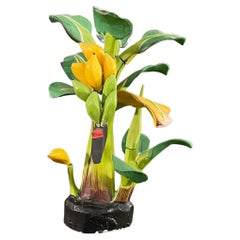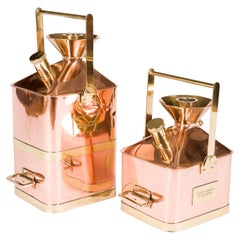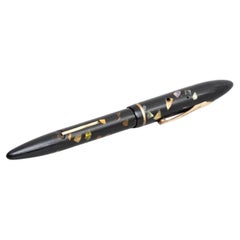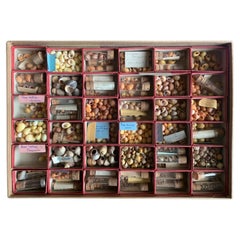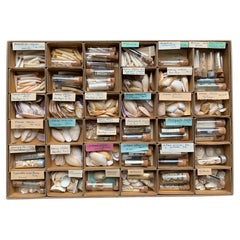Europe Scientific Instruments
to
79
938
598
936
1
1
92
83
36
31
21
17
14
8
8
7
6
4
3
3
2
2
1
96
344
496
2
246
178
28
21
37
25
26
13
34
23
15
5
476
378
241
128
128
787
285
151
124
113
938
937
938
8
6
4
3
3
Item Ships From: Europe
Italian Modern Wooden Botanic Model
By Robert Brendel
Located in Roma, IT
A botanic didactical specimen in the manner of the famous German botanist Robert Brendel.
"In the late 19th century Robert Brendel and his son Reinhold produced beautiful and accur...
Category
Mid-20th Century Italian Mid-Century Modern Europe Scientific Instruments
Materials
Wood
Copper & brass fuel measures by Sutherland Astell
Located in London, GB
Two copper and brass metric "Checkpump" fuel measures by Sutherland Astell, circa 1950.
Made for the County Borough of Blackpool.
Marked: 10 and 20 litres, at 20°.
20L, Height: 23...
Category
Mid-20th Century English Europe Scientific Instruments
Materials
Brass, Copper
Vintage Sheaffer Fountain Pen, circa 1950
By Montblanc
Located in Barcelona, ES
Sheaffer fountain pen, circa 1950. Manufactured by Sheaffers In original condition, with some visible signs of previous use and age, preserving a beautiful patina. Materials...
Category
1950s Spanish Mid-Century Modern Vintage Europe Scientific Instruments
Materials
Metal
$403 Sale Price
77% Off
Curiosity Cabinet Naturalism Collection of Shell circa 1900
Located in Beuzevillette, FR
Very interesting set of shells collected by an amateur between the end of the 19th century and the beginning of the 20th century. The shells are classified by size and age either in ...
Category
Early 20th Century French Europe Scientific Instruments
Materials
Shell
Antique Officer of the Watch Telescope, English, Terrestrial, Astronomical, Ross
Located in Hele, Devon, GB
This is an antique officer of the watch telescope. An English, leather and nickel silver single draw refractor for terrestrial or astronomical use, by Ross of London, circa 1920.
...
Category
Late 19th Century British Antique Europe Scientific Instruments
Materials
Leather
Curiosity Cabinet Naturalism Collection of Shell, Circa 1900
Located in Beuzevillette, FR
Very interesting set of shells collected by an amateur between the end of the 19th century and the beginning of the 20th century. The shells are classified by size and age either in ...
Category
20th Century French Europe Scientific Instruments
Materials
Shell
Curiosity Cabinet Collection of Shells, Circa 1900
Located in Beuzevillette, FR
Very interesting set of shells collected by an amateur between the end of the 19th century and the beginning of the 20th century. The shells are classified by size and age either in ...
Category
Early 20th Century French Europe Scientific Instruments
Materials
Shell
Curiosity Cabinet Naturalism Collection of Shell Circa 1900
Located in Beuzevillette, FR
Very interesting set of shells collected by an amateur between the end of the 19th century and the beginning of the 20th century. The shells are classified by size and age either in ...
Category
Early 20th Century French Europe Scientific Instruments
Materials
Shell
Antique English Folding Brass Magnifying Glass c.1910
Located in Bath, GB
A brass folding pocket magnifying glass which is made also to be added to a chain or ribbon to be worn around the neck.
The lens has a good magnification and in lovey condition.
D...
Category
1910s British Edwardian Vintage Europe Scientific Instruments
Materials
Brass
Wood and glass wall barometer station signed Lufft 1950s
Located in Milan, IT
Table or wall-mounted wood and glass barometer station signed Lufft from the 1950s, made for the Italian market and consisting of aneroid barometer, thermometer and hygrometer.
Buono...
Category
1950s Vintage Europe Scientific Instruments
Materials
Wood
Male anatomical model in painted stuccoed fiber. First half of the 20th century.
Located in Leuven , BE
Male anatomical model in painted stuccoed fiber. First half of the 20th century. Beautiful patina. Height: 30 cm.
Category
Early 20th Century French Europe Scientific Instruments
Materials
Natural Fiber, Parchment Paper
Curiosity Cabinet Collection of Shell, Circa 1900
Located in Beuzevillette, FR
Very interesting set of shells collected by an amateur between the end of the 19th century and the beginning of the 20th century. The shells are classified by size and age either in ...
Category
Early 20th Century Europe Scientific Instruments
Materials
Shell
Gruchon & Emons Paris 1918 magnetic compass for U.S Engineer Corps
Located in Milan, IT
Rare nautical survey magnetic compass, brass pocket, signed Gruchon & Emons Paris No. 81 1918, made for U.S Engineer Corps and in use by officers during World War I. This is a smal...
Category
1910s Vintage Europe Scientific Instruments
Materials
Brass
Antique Cased Octant, Scottish, Ebony, Navigation Instrument, Sextant, Victorian
Located in Hele, Devon, GB
This is an antique cased octant. A Scottish, ebony navigational instrument, dating to the Victorian period, circa 1850.
Appealing navigation ins...
Category
1850s British Early Victorian Antique Europe Scientific Instruments
Materials
Ebony, Walnut
Rare 18th Century Equatorial Sundial And Compass By Johann Nepomuk Schrettegger
Located in Bilzen, BE
"Rare 18th Century Equatorial Sundial And Compass By Johann Nepomuk Schrettegger,"
Rare 18th-Century Equinoctial Sundial & Compass by Johann Nepomuk Schrettegger, Augsburg
Maker: Joh...
Category
18th Century German Louis XVI Antique Europe Scientific Instruments
Materials
Brass
Ptolemaic Armillary Sphere, Charles-François Delamarche, Paris, ante 1798
By Charles Francois Delamarche
Located in Milano, IT
Ptolemaic armillary sphere
Charles-François Delamarche
Paris, ante 1798
Wood and papier-mâché
covered with printed and partly hand-colored paper
It measures 16.37 in in height x Ø 10.94 in (41.60 cm - Ø 27.80 cm)
It weights 2.33 lb (1,058 g)
State of conservation: consistent with its age and use, the paper shows some signs of use, stains and abrasions.
The sphere is Ptolemaic, with the Earth placed at its center, surrounded by the Moon and the Sun mounted on two metal arms.
The sphere is composed of six horizontal and two vertical rings (armillae), each bearing graduations and its own name.
The first horizontal ring is illegible. The others, in descending order are: North Pole, Tropic of Cancer, Equator, Tropic of Capricorn, South Pole.
The vertical rings consist of two double meridians.
The sphere is then connected to the large meridian by two pins, a vertical ring inserted perpendicularly into the circle of the Horizon, in turn supported by four semicircles connected to the turned and black-stained wooden base.
Each element is covered with printed paper. It contains various pieces of information: latitudes, length of days, names and zodiac symbols, calendar, wind directions, etc.
The vertical circles mention the latitudes and longitudes of different cities: Rome, Bordeaux, Madrid, Boston, Batavia (Jakarta), Acapulco, etc.
Even the small terrestrial globe is covered with printed paper: continents and oceans appear with numerous geographical markings indicating the most recent explorations.
In the Pacific Ocean, west of South America bears the following inscription:
GLOBE
TERRESTRIAL
à Paris
chez Delamarche Géog
Rue du Foin Jacques
Au Collège de
M.e Gervais
The North American coasts are well delineated and California appears correctly as a peninsula - reports from Spanish explorers in the region had given rise to confusion as to whether it was connected to the mainland or not. The geographical nature of California was confirmed after the explorations of Juan Bautista de Anza (1774-1776).
Alaska is not described and is only partially traced; it would become part of the United States in 1867.
Various Pacific islands are indicated.
Australia (the name definitely used from 1824) is called "Nouvelle Hollande."
Tasmania is still represented as a peninsula and this is an important detail for the dating of our armillary sphere.
The island is separated from Australia by Bass Strait, which was crossed by Matthew Flinders for the first time in 1798, showing that it was not a peninsula. Delamarche certainly would not have waited a long time to update such an important geographical datum: presumably he did so shortly after receiving the news.
Charles-François Delamarche (1740-1817) founded his laboratory around 1770 and, in a few years, he became the most famous French cartographer and globe maker between the 18th and 19th centuries. After having acquired the laboratory of the late Didier Robert de Vaugondy (1723-1786; himself a renowned cartographer who continued the family business founded by his grandfather Nicolas Sanson in the seventeenth century) and after having purchased, between 1788 and around 1800, the businesses of Jean-Baptiste Fortin (1750-1831) and Jean Lattré (around 1750-1800), he began to call himself "Successeur de MM. Sanson and Robert de Vaugondi, Géographes du Roi and de M. Fortin, Ingénieur-mécanicien du Roi pour les globes et les sphères."
Thus, at the end of the eighteenth century, Delamarche possessed the warehouse stocks, as well as the manufacturing skills of the globes of his main rivals in Paris.
In addition to this aggressive acquisition policy, the key to its success also lay in the combination of high-quality cartography combined with extremely attractive globes and armillary spheres; and, of course, its famous red paint finishing touch.
His laboratory was located on Rue de Foin St Jacques "au Collège Me. (or "Mtre") Gervais" in the Latin Quarter of Paris until around 1805, when he moved to rue du Jardinet No. 13.
On the death of Charles-François in 1817, the reins of the company passed to his son Félix (1779-1835), who continued to publish, often in collaboration with the engraver Charles Dien, Sr. In 1835 the company first moved to rue du Jardinet No. 12 and a little later to rue du Battoir No. 7.
Bibliography:
Dekker, Elly, et al. Globes at Greenwich...
Category
1790s French Other Antique Europe Scientific Instruments
Materials
Wood, Paper
Antique English Brass Cased Compass Reg. No. For 1903
Located in Bath, GB
A handsome cased late Victorian or Edwardian compass with hinged lid, the little button on the top used to open; just like a full hunter pocket watch.
The dial is lucky enough to ha...
Category
Early 1900s British Edwardian Antique Europe Scientific Instruments
Materials
Brass
Curiosity Cabinet Naturalism Collection of Shells Circa 1900
Located in Beuzevillette, FR
Very interesting set of shells collected by an amateur between the end of the 19th century and the beginning of the 20th century. The shells are classified by size and age either in ...
Category
Early 20th Century French Europe Scientific Instruments
Materials
Shell
Antique 3 Draw Telescope, English Brass, Terrestrial Instrument, Victorian, 1880
Located in Hele, Devon, GB
Perfect for bird watching, landscape appreciation, wildlife, or maritime observation. Equally suitable for observing the night sky.
This is an antique 3-draw telescope. An English, ...
Category
1880s British Late Victorian Antique Europe Scientific Instruments
Materials
Brass
1930s Educational Model Papier Maché and Plaster Decipting a Baby Borning
Located in Milan, IT
Educational model, papier maché and plaster, decipting a baby borning. 1930s-1940s, sold by the Hygiene Museum in Dresden. Very good condition. Measu...
Category
1930s Vintage Europe Scientific Instruments
Materials
Plaster
Curiosité Cabinet Collection of Shell Circa 1900
Located in Beuzevillette, FR
Very interesting set of shells collected by an amateur between the end of the 19th century and the beginning of the 20th century. The shells are classified by size and age either in ...
Category
Early 20th Century Europe Scientific Instruments
Materials
Shell
Navy Binoculars
Located in Paris, FR
Binoculars Navy with polished steel adjustable tripod base.
With polished aluminium and steel binoculars with clear glass
lens, magnifying x8 times. Adjust...
Category
21st Century and Contemporary Indian Europe Scientific Instruments
Materials
Aluminum, Steel
$7,016
Antique Victorian Quality Carved Oak Banjo Barometer
Located in Suffolk, GB
Antique Victorian quality carved oak banjo barometer having a quality carved oak shaped case with a brass bezel, porcelain dial with original hands and a thermometer
An attractive ...
Category
19th Century English Victorian Antique Europe Scientific Instruments
Materials
Oak
Brass compass with mother of pearl dial from WW1 period , English circa 1914
Located in Central England, GB
This superb example of an early 20th century heavy folding brass compass is of a design and type often issued to officers in the First World War.
This fine example is not marked for...
Category
Early 20th Century British Other Europe Scientific Instruments
Materials
Brass
Automa Tedesco Gabbia Con Uccello Cantante e Animato 1920s Karl Griesbaum
By Karl Griesbaum
Located in Milano, MI
Automa Animato Tedesco Gabbia Con Uccellino del 1920 circa costituito da una gabbia rotonda in ottone dorato con al suo interno un uccello animato canterino su di un trespolo con un ...
Category
Early 19th Century German Art Deco Antique Europe Scientific Instruments
Materials
Brass
Antique Technical Drawing Set, German, Architect, Cartography, Wichmann
Located in Hele, Devon, GB
This is an antique technical drawing set. A German, architect's or cartographer's instrument case by Wichmann, dating to the early 20th c...
Category
Early 20th Century German Edwardian Europe Scientific Instruments
Materials
Nickel
Antique Vineyard Setter's Compass, French, Brass, Surveyor's Instrument, C.1900
Located in Hele, Devon, GB
This is an antique vineyard setter's compass. A French, brass surveyor's instrument with mahogany case and stand, dating to the late Victorian period, c...
Category
Late 19th Century French Antique Europe Scientific Instruments
Materials
Brass
Pair of English 12-inch Globes by William Harris, London, 1832 and 1835
By William Harris
Located in Milano, IT
Pair of 12-inch table globes
William Harris
London, 1832 and 1835
Slight abrasions from use; few cracks
lb 11 each (kg 5)
The two terrestrial and celestial globes rest in their original Dutch style stands with four supporting turned wood columns.
Each one measures 12 in in height x 16.5 in in diameter with the diameter of the spheres measuring approximately 12 in; 48 cm in height x 42 cm in diameter x 31 cm diameter of the spheres.
The 12 inch measure was the most frequently used by British manufacturers of globes of this period.
Each globe is composed of two series of twelve printed paper gores, aligned and glued onto plaster spheres.
The brass circle of the meridian bears engravings...
Category
1830s English William IV Antique Europe Scientific Instruments
Materials
Paper, Wood
Old Compass reproduction 1944 London, brown Color
Located in Auribeau sur Siagne, FR
Old Compass reproduction 1944 London, brown Color
Category
20th Century English Europe Scientific Instruments
Materials
Metal
$130 Sale Price
20% Off
Large Arts & Crafts Hand-Carved Nutwood Barometer with Thermometer, Early 1900s
Located in Lisse, NL
This rare and decorative early 20th-century Arts & Crafts wall barometer and thermometer is a striking testament to Dutch craftsmanship. Hand-carved from a single solid piece of rich...
Category
Early 20th Century European Arts and Crafts Europe Scientific Instruments
Materials
Metal, Brass
Pair of Antique Opera Glasses, English, Leather, Brass, Binoculars, Ross London
Located in Hele, Devon, GB
This is a pair of antique opera glasses. An English, leather and brass binocular by Ross of London, dating to the early 20th century, circa 1920.
A charming and original example of ...
Category
1920s British Edwardian Vintage Europe Scientific Instruments
Materials
Brass
Fine Pair Golden Guilloche Enamel and Mother of Pearl Opera Glasses, c.1910
Located in Bath, GB
Pretty as a picture and in outstanding condition, this lovely pair of early twentieth century opera glasses come complete with their original case (wear commensurate with age).
Th...
Category
1910s French Vintage Europe Scientific Instruments
Materials
Brass, Enamel
A Fine Adams, London Culpepper Microscope
Located in Lincolnshire, GB
A late 18th century brass lacquered Culpepper design microscope by Adams, London in the original mahogany case. The two drawers contain a good selection of lenses and accessories.
Th...
Category
Late 18th Century English Antique Europe Scientific Instruments
Materials
Brass
Antique Rolling Ruler, English Cartographer’s Instrument, Architect, Edwardian
Located in Hele, Devon, GB
This is a fine antique cased rolling ruler. An English brass cartographer's or architect's instrument, dating to the Edwardian period, circa 1910. A superb example of precision engin...
Category
Early 1900s British Edwardian Antique Europe Scientific Instruments
Materials
Brass
Occasus Ortus: An Astronomical Measuring Device for Angular Precision, c.1780
Located in Langweer, NL
This print, titled "Occasus Ortus", showcases a highly detailed engraving of an 18th-century measuring device, likely related to astronomy or navigation.
The design features various components of the instrument arranged systematically, with each part labeled by figure numbers. The centerpiece is a large circular protractor...
Category
1780s European Antique Europe Scientific Instruments
Materials
Paper
$298 Sale Price
20% Off
English Pocket Globe, London, Circa 1775-1798
By Herman Moll
Located in Milano, IT
Pocket globe
London, between 1775 and 1798
Re-edition of the globe of Hermann Moll (1678-1732) dated 1719
The globe is contained in its original case, which itself is covered in shark skin.
There are slight gaps in the original paint on the sphere. The case no longer closes.
The sphere measures 2.7 in (7 cm) in diameter whereas the case measures 2.9 in (7.4 cm) in diameter.
lb 0.22 (kg 0.1)
The globe is made up of twelve printed paper gores aligned and glued to the sphere.
In the North Pacific Ocean there is a cartouche with the inscription:
A Correct
Globe
with the new
Discoveries.
The celestial globe is depicted on the inside of the box and is divided into two hemispheres with the cartouche:
A correct globe
with ye new cons
relations of Dr.
Halley & c.
It shows the ecliptic divided into the days of the zodiacal calendar and the constellations represented as animals and mythological figures.
On the globe are delineated the equinoctial line, divided by degrees and hours, the ecliptic and the meridian (passing west of Greenwich). The continents are shaded and outlined in pink, green and yellow. It shows: the Cook routes; a wind rose in the Southern Indian Ocean; Antarctica without land; Africa with Negroland (Hermann Moll is considered the first geographer to name the West African region in his 1727 map. (Encyclopaedia Britannica, ed. 1902, under "States of Central Africa"); Tartary in Central Asia; the Mogul kingdom in northern India; in North America only New England, Virginia, Carolina, Florida, Mississippi are identified; California is already a peninsula; the northwest coast of America is "unknown parts" (Alaska is not described and it is only partially delineated, it was to become part of the United States in 1867); Mexico is named "Spain"; Central South America "Amazone America". Australia (which was to be so named after 1829) is called New Holland. The route of Admiral Anson is traced (1740) and the trade winds are indicated by arrows. (See Van der Krogt, P., Old Globes in the Netherlands, Utrecht 1984, p. 146 and Van der Krogt, P. - Dekker, E., Globes from the Western World, London 1993, pp. 115.)
Elly Dekker, comparing Moll’s 1719 globe and his re-edition (of which the one described above is a sample), identifies the differences between them: the two editions are quite similar to each other, but in the "anonymous" globe, compared to the previous globe of 1719, California looks like a proper peninsula - the reports of the Spanish explorers of the region had given rise to uncertainty over whether it was connected to the mainland or not. The geographical nature of California was confirmed after the explorations of Juan Bautista de Anza (1774-1776). The routes of Dampier's journey were partially erased and the route of Captain James Cook's first voyage was superimposed on them, and the geography of Australasia was adapted accordingly, including the denomination of the Cook Strait. See Dekker, Elly, Globes at Greenwich, 1999.
An important ante quem element is represented by Tasmania: it is not separated from Australia by the Bass Strait...
Category
Late 18th Century English George III Antique Europe Scientific Instruments
Materials
Shagreen, Paper
Antique Box Field Camera and Tripod, English, Accessories, Ornamental, Victorian
Located in Hele, Devon, GB
This is an antique Field Camera and tripod. An English, mahogany and brass plate camera with accessories and lens, dating to the late Victorian p...
Category
Late 19th Century British Late Victorian Antique Europe Scientific Instruments
Materials
Brass
London Mid-19th Century Vanity Kit Set Sterling Silver
Located in Brescia, IT
Not easy to find this original box, with this kit set composed of 8 pieces for nail manicure. A piece to collect or to add in a wunderkammer.
In sterling silver, all marked.
With ce...
Category
Mid-19th Century British Baroque Antique Europe Scientific Instruments
Materials
Crystal, Sterling Silver
$349 Sale Price / set
25% Off
Ptolemaic Armillary Sphere, Charles-François Delamarche, Paris, ante 1798
By Charles Francois Delamarche
Located in Milano, IT
Ptolemaic armillary sphere
Charles-François Delamarche
Paris, ante 1798
Wood and papier-mâché
covered with printed and partly hand-colored paper
It measures 15.55 in in height x Ø 10...
Category
1790s French Other Antique Europe Scientific Instruments
Materials
Wood, Paper
Vintage Panasonic Toot-a-Loop-Radio, 1970s
Located in Roma, IT
Vintage Panasonic toot-a-loop-radio is an original decorative object realized in the 1970s by Panasonic R-72 (R72) and built by Matsushita Electric Industrial Co
This radio is the...
Category
1970s Japanese Vintage Europe Scientific Instruments
Materials
Plastic
$228 Sale Price
30% Off
Vintage Tesla Telephone Set With Original Maker’s Mark, 1960s
By Tesla
Located in Zohor, SK
This elegant vintage telephone set by Tesla showcases the original maker’s stamp on the underside, confirming its authenticity. Its streamlined curves and timeless design reflect mid...
Category
1960s Czech Mid-Century Modern Vintage Europe Scientific Instruments
Materials
Bakelite
Antique Pair of Cased Binoculars, English, Brass, Optical Instrument, Victorian
Located in Hele, Devon, GB
This is an antique pair of cased binoculars. An English, enamel brass optical instrument, dating to the Victorian period, circa 1900.
Appealing weathering and presented in an attrac...
Category
Early 20th Century British Late Victorian Europe Scientific Instruments
Materials
Brass
Vintage 3-Draw Telescope, English, Navigation, Astrological, Broadhurst Clarkson
Located in Hele, Devon, GB
This is a vintage 3-draw telescope. An English, leather and brass navigational or astronomical instrument, dating to the early 20th century, circa 1930.
Perfect for bird watching, l...
Category
1930s British Mid-Century Modern Vintage Europe Scientific Instruments
Materials
Brass
Glass scientific instrument: Crookes maltese cross tube, Italy 1900.
Located in Milan, IT
Blown glass scientific instrument. An example of the Crookes tube with Maltese Cross, in chromed metal, a precursor to the cathode ray tube. It was used t...
Category
Early 20th Century Italian Europe Scientific Instruments
Materials
Metal
Antique Wrap Reel Machine, English, Factory, Cotton, John Nesbitt, Victorian
Located in Hele, Devon, GB
This is an antique rotary wrap reel machine. An English, brass and cast iron factory cotton skein winder by John Nesbitt of Manchester, dating to the late...
Category
Late 19th Century British Victorian Antique Europe Scientific Instruments
Materials
Bronze
18th Century mahogany and brass telescope by Nairne & Blunt of London
Located in Martlesham, GB
18th Century mahogany and brass telescope by Nairne & Blunt of London, having a mahogany barrel with a thumb wheel to the side of the main barrel, supported on a solid brass tripod s...
Category
1780s British Georgian Antique Europe Scientific Instruments
Materials
Mahogany
Spanish Moorish Gothic Mortar 15th century
Located in DELFT, NL
Spanish - Moorish Gothic bronze mortar and with ribs, most likely from Andalusia.
Of conical shape, resting on a circular base, the exterior decorated with a series of wing-shaped pr...
Category
15th Century and Earlier Spanish Gothic Antique Europe Scientific Instruments
Materials
Bronze
Bronze Pharmacy Mortar Italy-17° Century
Located in Brussels, Brussels
Elegant bronze mortar from the 17 century from Italy dated 1630.
Really rare mortar due to his big size.
In very good condition and beautiful patina.
Category
17th Century Italian Renaissance Antique Europe Scientific Instruments
Materials
Bronze
18th Century Diptych Portable Sundial And Compass by German Beringer
By David Beringer
Located in Milano, MI
Antique 18th Century Diptych Sundial and Compass a portable wooden boxwood sundial with compass, of German origin, by David Beringer, Nuremberg, dating back to the 1790 circa, in good age related condition, with signs of wear consistent with age and use.
David Beringer (1756 – 1821) was a German scientific instrument maker and craftsman active in Nuremberg and famous for his cubic wooden sundials visible in Metropolitan Museum of Art di New York.
A portable sundial...
Category
Late 18th Century German Antique Europe Scientific Instruments
Materials
Brass
Italian Radiophonograph RR126 and Record Player by Castiglioni, Brionvega 1960s
By Achille & Pier Giacomo Castiglioni, Brionvega
Located in MIlano, IT
Italian Radiophonograph RR126 and Record Player by Castiglioni Brothers for Brionvega, 1960s.
RR126 radio phonograph and turntable with a rectangular wooden base with dark brown prof...
Category
1960s Italian Modern Vintage Europe Scientific Instruments
Materials
Metal
Galvanometer Antique Measuring Instrument Used for Telegraph Cables 1850 circa
Located in Milan, IT
Vertical mirror galvanometer made in 1850 circa, oak and glass, three adjustable screws at the base. Tool constituted by a magnet bar movable inside a coil and connected to a needle. In the absence of current the needle is positioned vertically while when the coil is crossed by the current it creates a magnetic field that moves the needle. This type of galvanometer was used for measurement of insulation of telegraph cables...
Category
1850s British Antique Europe Scientific Instruments
Materials
Wood
Olivetti lettera DL by Sottsass Ettore design in years '70
By Ettore Sottsass, Olivetti
Located in Biella, IT
Olivetti lettera DL by Sottsass Ettore design in years '70 working
very good vintage with her original box
Category
1970s Italian Mid-Century Modern Vintage Europe Scientific Instruments
Materials
Metal
19th Century thermometer in original case
Located in Debenham, Suffolk
19th century thermometer in original case circa 1890.
Fine quality thermometer which measures between -45 degrees centigrade and +50. In fully working condition, complete in its ori...
Category
Late 19th Century Swedish Victorian Antique Europe Scientific Instruments
Materials
Glass, Paper
Anatomical model: a human skull model life size, Stuttgard, Germany 1930.
Located in Milan, IT
Human skull anatomical model life size 1:1 Model with cranial sutures detachable 2 parts plus three cervical vertebrae for medical educational aid. The skull and vertebrae are made o...
Category
Mid-20th Century German Europe Scientific Instruments
Materials
Iron
Italian or German anatomical bust.
Located in Lugo, IT
Italian or German anatomical bust.
The profile photos are without organs.
The measurements refer to the wooden base.
The conditions are as per the phot...
Category
1890s German Antique Europe Scientific Instruments
Materials
Gesso, Wood
18-inch Globe, Cary's, London, 1840
By Cary’s
Located in Milano, IT
John and William Cary
Updated by George and John Cary
Terrestrial Globe
London, 1840
lb 22 (kg 10)
Slight surface abrasions due to use. A small crack on the horizon circle.
The globe rests in its original Dutch style stand with four supporting turned wood columns.
It measures 26 in in height x 23.6 in in diameter with the diameter of the sphere measuring 18 in; 66 cm in height x 60 cm in diameter with the diameter of the sphere measuring 45.72 cm.
The 18 inch...
Category
1840s English Early Victorian Antique Europe Scientific Instruments
Materials
Paper, Wood
Austrian Bronze Mortar and Pestle, Original Patina, Pharmacy or Herbalist
Located in Nuernberg, DE
Offered is a beautiful antique solid brass mortar and pestle set. The mortar has a cylindrical shape with a flared mouth and two angular handles at the sides. The baton-shaped pestle...
Category
1920s Austrian Hollywood Regency Vintage Europe Scientific Instruments
Materials
Metal, Brass
Quality Antique Victorian Brass Scales
Located in Suffolk, GB
Quality antique Victorian brass scales having a quality set of brass scales with 2 circular brass pans standing on a brass tripod base
Quaint examples in...
Category
19th Century English Victorian Antique Europe Scientific Instruments
Materials
Brass
Vintage Beam Compass, German, Cartography, Architect Drawing Instrument, Riefler
Located in Hele, Devon, GB
This is a vintage beam compass. A German, silver nickel cartographer's or architect's drawing instrument by Riefler, dating to the late 20th cent...
Category
Late 20th Century German Mid-Century Modern Europe Scientific Instruments
Materials
Nickel
Round-section brass telescope with mahogany-lined handle 1850
Located in Milan, IT
Round-section brass telescope with mahogany-lined handle, four-extension focus. English manufacture from the mid-19th century. Good condition signs of wear and tear, fully functional...
Category
Mid-19th Century Antique Europe Scientific Instruments
Materials
Brass
Recently Viewed
View AllMore Ways To Browse
Medical Skull
Retro Weather Thermometer
Vintage Brass Telescope
Vintage Fire Department Collectibles
Vintage Military Tripod
Antique Brass Sundials
Antique Dental Instrument
Edwardian Barometers
Large Abacus
Movie Projector
Smoke Mask
Vintage Camera With Leather Case
18th Century Telescope
Antique Avery Scales
Antique Brass Surveying Instruments
Antique Toledo Scale Scales
Antique Toledo Scale
Georgian Barometers
